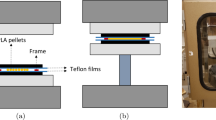Abstract
Experimental data are reported on polycarbonate in tensile tests with a constant strain rate and relaxation tests in a wide range of temperatures. It is demonstrated that the growth of temperature results in a decrease in Young’s modulus and a strong increase in the relaxation rate. Constitutive equations are developed for the non-isothermal linear viscoelastic response of glassy polymers when the rates of heating/cooling and stress relaxation are comparable. A good agreement is demonstrated between the observations in relaxation tests on polycarbonate, poly(methyl methacrylate), polystyrene, and epoxy resin, and results of simulation. The model is applied to the numerical analysis of creep flow under non-isothermal multi-step thermal programs.
Similar content being viewed by others
References
Drozdov, A.D., Christiansen, J.deC.: Creep failure of polypropylene: experiments and constitutive modeling. Int. J. Fract. 159, 63–79 (2009)
Drozdov, A.D.: Creep rupture and viscoelastoplasticity of polypropylene. Eng. Fract. Mech. 77, 2277–2293 (2010)
Guevara-Morales, A., Figueroa-Lopez, U.: Residual stresses in injection molded products. J. Mater. Sci. 49, 4399–4415 (2014)
Peters, K.: Polymer optical fiber sensors—a review. Smart Mater. Struct. 20, 013002 (2011)
Bilro, L., Alberto, N., Pinto, J.L., Nogueira, R.: Optical sensors based on plastic fibers. Sensors 12, 12184–12207 (2012)
Marques, C.A.F., Webb, D.J., Andre, P.: Polymer optical fiber sensors in human life safety. Opt. Fiber Technol. 36, 144–154 (2017)
Large, M.C.J., Moran, J., Ye, L.: The role of viscoelastic properties in strain testing using microstructured polymer optical fibres (mPOF). Meas. Sci. Technol. 20, 034014 (2009)
Saez-Rodriguez, D., Nielsen, K., Bang, O., Webb, D.J.: Time-dependent variation of fiber Bragg grating reflectivity in PMMA-based polymer optical fibers. Opt. Lett. 40, 1476–1479 (2015)
McCrum, N.G.: Inadequacies in time-temperature equivalence. J. Polym. Sci. A 2, 3951–3950 (1964)
Buckley, C.P.: Prediction of stress in a linear viscoelastic solid strained while cooling. Rheol. Acta 27, 224–229 (1988)
Drozdov, A.D.: A model for the non-isothermal viscoelastic behavior of polymers. Polym. Eng. Sci. 37, 1983–1997 (1997)
Green, M.S., Tobolsky, A.V.: A new approach to the theory of relaxing polymeric media. J. Chem. Phys. 14, 80–92 (1946)
Richeton, J., Schlatter, G., Vecchio, K.S., Remond, Y., Ahzi, S.: A unified model for stiffness modulus of amorphous polymers across transition temperatures and strain rates. Polymer 46, 8194–8201 (2005)
Chen, K., Schweizer, K.S.: Microscopic constitutive equation theory for the nonlinear mechanical response of polymer glasses. Macromolecules 41, 5908–5918 (2008)
Wang, H., Zhou, H., Huang, Z., Zhang, Y., Zhao, X.: Constitutive modeling of polycarbonate over a wide range of strain rates and temperatures. Mech. Time-Depend. Mater. 21, 97–117 (2017)
Sollich, P.: Rheological constitutive equation for a model of soft glassy materials. Phys. Rev. E 58, 738–759 (1998)
Chen, Y.C., Kuang, J.H., Chen, L.W., Chuang, H.C.: Effect of plastic strain energy density on polymer optical fiber power losses. Opt. Lett. 31, 879–881 (2006)
Abang, A., Webb, D.J.: Effects of annealing, pre-tension and mounting on the hysteresis of polymer strain sensors. Meas. Sci. Technol. 25, 015102 (2014)
Richeton, J., Ahzi, S., Vecchio, K.S., Jiang, F.C., Makradi, A.: Modeling and validation of the large deformation inelastic response of amorphous polymers over a wide range of temperatures and strain rates. Int. J. Solids Struct. 44, 7938–7954 (2007)
Dupaix, R.B., Boyce, M.C.: Constitutive modeling of the finite strain behavior of amorphous polymers in and above the glass transition. Mech. Mater. 39, 39–52 (2007)
Srivastava, V., Chester, S.A., Ames, N.M., Anand, L.: A thermo-mechanically-coupled large-deformation theory for amorphous polymers in a temperature range which spans their glass transition. Int. J. Plast. 26, 1138–1182 (2010)
Mathiesen, D., Vogtmann, D., Dupaix, R.B.: Characterization and constitutive modeling of stress-relaxation behavior of poly(methyl methacrylate) (PMMA) across the glass transition temperature. Mech. Mater. 71, 74–84 (2014)
Abdel-Wahab, A.A., Ataya, S., Silberschmidt, V.V.: Temperature-dependent mechanical behaviour of PMMA: experimental analysis and modelling. Polym. Test. 58, 86–95 (2017)
Cao, K., Wang, Y., Wang, Y.: Effects of strain rate and temperature on the tension behavior of polycarbonate. Mater. Des. 38, 53–58 (2012)
Cao, K., Wang, Y., Wang, Y.: Experimental investigation and modeling of the tension behavior of polycarbonate with temperature effects from low to high strain rates. Int. J. Solids Struct. 51, 2539–2548 (2014)
Bauwens-Crowet, C., Bauwens, J.-C., Homes, G.: The temperature dependence of yield of polycarbonate in uniaxial compression and tensile tests. J. Mater. Sci. 7, 176–183 (1972)
Inoue, T., Okamoto, H., Osaki, K.: Large deformation of polycarbonate near the glass transition temperature. Macromolecules 25, 7069–7070 (1992)
Onu, A., Legras, R., Mercier, J.P.: Phase equilibrium and glass-transition temperatures in plasticized amorphous bisphenol-A polycarbonate. J. Polym. Sci.: Polym. Phys. Ed. 14, 1187–1199 (1976)
Yee, A.F., Bankert, R.J., Ngai, K.L., Rendell, R.W.: Strain and temperature accelerated relaxation in polycarbonate. J. Polym. Sci. B: Polym. Phys. 26, 2463–2483 (1988)
Mariani, P., Frassine, R., Rink, M., Pavan, A.: Viscoelasticity of rubber-toughened poly(methyl methacrylate). Part I: deformational behavior. Polym. Eng. Sci. 36, 2750–2757 (1996)
Roetling, J.A.: Yield stress behaviour of polymethylmethacrylate. Polymer 6, 311–317 (1965)
Sondhauss, J., Lantz, M., Gotsmann, B., Schirmeisen, A.: \(\beta \)-relaxation of PMMA: tip size and stress effects in friction force microscopy. Langmuir 31, 5398–5405 (2015)
Rek, V., Grguric, T.H., Jelcic, Z.: Creep relaxation and stress relaxation of PS-HI/SEBS blends. Macromol. Symp. 202, 127–141 (2003)
Kimmel, R.M., Uhlmann, D.R.: Activation energy spectra for relaxation in amorphous materials. I. Volume relaxation in polystyrene and polyvinyl acetate. J. Appl. Phys. 40, 4254–4260 (1969)
Huang, C.-L., Chen, Y.-C., Hsiao, T.-J., Tsai, J.-C., Wang, C.: Effect of tacticity on viscoelastic properties of polystyrene. Macromolecules 44, 6155–6161 (2011)
Kim, Y.K., White, S.R.: Stress relaxation behavior of 3501–6 epoxy resin during cure. Polym. Eng. Sci. 36, 2852–2862 (1996)
Wan, J., Li, C., Bu, Z.-Y., Fan, H., Li, B.-G.: Acrylonitrile-capped poly(propylene imine) dendrimer curing agent for epoxy resins: model-free isoconversional curing kinetics, thermal decomposition and mechanical properties. Mater. Chem. Phys. 138, 303–312 (2013)
Author information
Authors and Affiliations
Corresponding author
Rights and permissions
About this article
Cite this article
Drozdov, A.D., Christiansen, J.d. Modeling the non-isothermal viscoelastic response of glassy polymers. Acta Mech 229, 1137–1156 (2018). https://doi.org/10.1007/s00707-017-2053-7
Received:
Revised:
Published:
Issue Date:
DOI: https://doi.org/10.1007/s00707-017-2053-7




